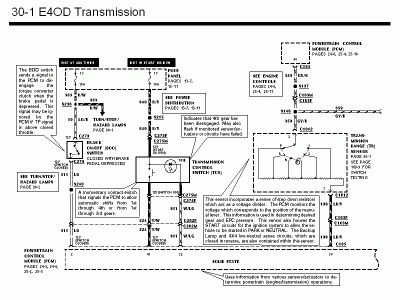Yo mansolis,
E4OD Transmission Control Indicator Light (TCIL) Overview;
" is a LED with an overdrive on/off switch at end of the Transmission shifter stalk;
flashing OD light is an indication of a transmission related trouble code in the Powertrain Control Module (PCM).
The transmission control switch is a momentary contact switch. When the switch is pressed, a signal is sent to the powertrain control module (PCM) (12A650). The powertrain control module then energizes the transmission control indicator lamp and the coast clutch solenoid, applying the coast clutch to provide engine braking and cancels fourth gear operation;
The TCIL indicates overdrive cancel mode activated (lamp on), electronic pressure control circuit shorted or monitored sensor failure (lamp flashing).
●LAMP ON, NO CODES Possible Causes:
Switch is damaged.
Shorted harness.
Damaged Powertrain Cont

rol Module (PCM).
Open harness or fuse.
95 E4OD Wiring Diagram
Try a Self Test for Diagnostic Trouble Codes (DTC)s by my pal, BroncoJoe19 @
Code Reader
EEC AKA PCM, computer stores the Self-Test program in permanent memory. When activated, Self-Test checks the EEC system by testing memory integrity and processing capability, and verifies that various sensors and actuators are connected and operating properly.
The EEC will tell you what it found out by testing your sensors, and also any stored information it saved from anything that went wrong during the last 40 trips.
The engine temperature must be greater than 50° F for the Key On Engine Off (KOEO) Self-Test and greater than 180° F for the Key On Engine Running (KOER) Self-Test. Run it around to heat the engine up and shift thru all gears including Reverse. Make sure A/C is off and transmission is in Park (automatic); or in Neutral for a Manual & release clutch. Then turn off engine, all accessories/lights (close driver's door) , etc.
Do KOEO test First. Post Code(s) here according to KOEO & KOER.
A helper can assist you by counting the codes. Some use their smart phones to record them.
BEWARE OF FAN, BELTS, PULLEYS, HOT HOSES, IGNITION HIGH TENSION WIRES, AND ENGINE COMPONENTS
Or ask local mom and dad parts stores if they will test it for you.
■
Here are some PCM KILLER perpetrators and other causes:
Smell around the PCM. If it smells like dead fish, it's bad.
Look for PCM printed circuit board burn marks around leaking capacitors, resistors.
View attachment 182797
For example, see Old leaky capacitors in
swapped EEC and no more codes by jowens1126
Water damage from cowl leaks, ESPECIALLY if you you have wet carpet or mat near driver kick panel; or on PCM Connector due to a bad hood seal near cowl panel, viewable with hood up.
Corrosion or damage due to moisture is one of the main reasons for failure. Corrosion can enter through the wiring harness and moisture can enter by a failure in the seals in the PCM itself. This happens over a period of time (5 to 10 years) due to exposure to the elements.
The alternator could be generating an AC voltage spike due to bad diode(s) or supply Voltage
View attachment 182796
Overloads.
I recommend bench-testing the alternator for voltage output and AC voltage ripple.
Thermal stress due to excessive heat and excessive vibration that causes sensitive parts to fail.
Bronco was jump started on reverse polarity.
Connector pin damage or corrosion,
Other internals:
broken tracks,
cold solder joints,
short circuit,
thermal stress due to excessive heat and excessive vibration that causes sensitive parts to fail,
Overheated PC,.
Bad Intel 8061 chip or bad Intel 8361 memory chip,
Bad Internal Voltage Regulator, see
Wayback Machine by absent member Fireguy50 (Ryan M)

